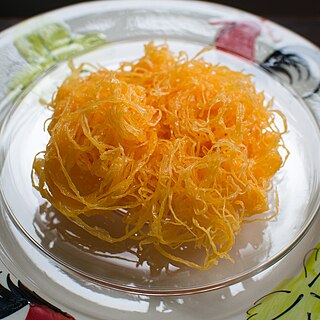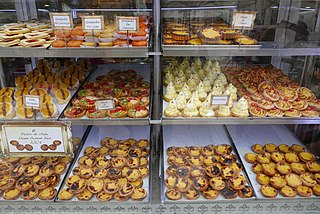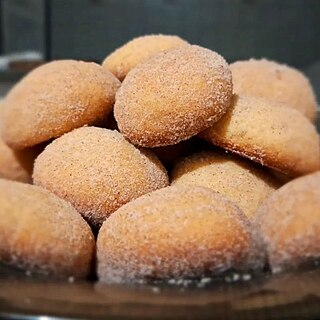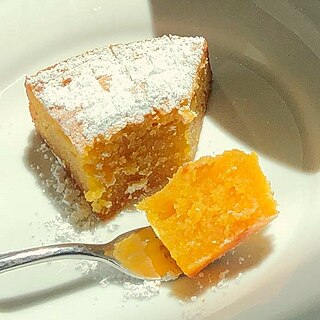
Ovos moles de Aveiro —sometimes written as ovos-moles de Aveiro—are a local pastry delicacy from Aveiro District, Portugal, made of egg yolks and sugar, and sometimes chocolate. This mixture is then put inside small rice paper casings or wheat flour casings similar to communion wafers shaped into nautical shapes such as shells.

The oldest known book on Portuguese cuisine, entitled Livro de Cozinha da Infanta D. Maria de Portugal, from the 16th century, describes many popular dishes of meat, fish, poultry and others.

Quindim is a popular Brazilian baked dessert with Portuguese heritage, made chiefly from sugar, egg yolks and ground coconut. It is a custard and usually presented as an upturned cup with a glistening surface and intensely yellow color. The mixture can also be made in a large ring mold in which case it is called a "quindão" and served in slices.

Papo de anjo or papo-de-anjo, roughly translated as "angel's double chin", is a traditional Portuguese dessert made chiefly from whipped egg yolks, baked and then boiled in sugar syrup.
Maria Guyomar de Pina, Thao Thong Kip Ma, was a Siamese woman of mixed Japanese-Portuguese-Bengali ancestry who lived in Ayutthaya in the 17th century. She became the wife of Greek adventurer Constantine Phaulkon.

Fios de ovos is a traditional Portuguese sweet food made of eggs, drawn into thin strands and boiled in sugar syrup. They can be found in Thai dessert and been traditional dish since 16th centuries, around 1679. They are a traditional element in Portuguese and Brazilian cuisine, both in desserts and as side dishes.

Bua loi or bua loy is a Thai dessert. It consists of rice flour rolled into small balls, and cooked in coconut milk and sugar. Some Bua loi also adds sweet egg into the recipe. It was inspired by Tangyuan, a Chinese dessert that is traditionally eaten around the Lantern festival. Bua Loi also traditionally eats at the Dongzhi Festival in Thailand, which is festival for the Chinese-Thai bloodline. There are a variety of versions of Bua loi such as using food coloring instead of natural color, using soy milk instead of Coconut cream, sliced Pumpkin to add inside rice balls, et cetera. There's other type of Bua loi in other country from China, Japan, Indonesia, Myanmar, Philippines, and Southern Vietnam. 1 cup of Bua Loy has total calories of 295.5 kilocalories, protein of 10.4 grams, carbohydrate of 6.3 grams, and fat of 25 grams.

Tocino de cielo is a Spanish dessert made primarily of egg yolks, sugar, and water. It is often confused for a custard. Unlike flan, it does not contain milk or any other dairy product. It is sometimes mistakenly called tocino del cielo.
Doce de ovos is a sweet egg cream from Portuguese cuisine made with egg yolks and simple syrup. It is used as a filling for layered sponge cakes, and can be used as a sweet topping for ice creams and other desserts like Natas do Céu. The cream must be prepared at low temperature or in a bain marie to prevent the egg yolks coagulating.

Conventual sweets are a typical part of the Portuguese cuisine and a generic term to a variety of sweets in Portugal. As the name implies, conventual sweets were made by nuns who lived in the Portuguese convents and monasteries. Starting in the 15th century, these sweets have since integrated in the Portuguese cuisine and in former Portuguese colonies. Conventual sweets have sugar, egg yolks and almond as ingredients of choice.

Pão de Rala is an historical conventual dessert created by the Poor Clare nuns in the Convento de Santa Helena do Calvário in Évora. It is often accompanied by olives shaped out of marzipan and dusted with cocoa, per legend.

Doce de gila is a Portuguese fruit preserve made from the pulp of the Cucurbita ficifolia. It can be used as jam or as an ingredient in various desserts and pastries.

Azevias are traditional Portuguese fried pastries, turnovers filled with a sweet filling.

Areias are small traditional Portuguese pastries similar to cakes and biscuits. They are commonly coated with coarse-grain sugar, and sometimes cinnamon, which resemble sand for which areias are named after.

Pão de Ló is a Portuguese sponge cake made of eggs, sugar, and wheat flour. Unlike other cakes or breads, yeast or baking powder is generally not used. Rather, to provide volume, air is suspended into the cake batter during mixing.

Torta de Azeitão is a Portuguese roll cake filled with doces de ovos from the parish of Azeitão.

Toucinho do Céu is a Portuguese dessert made primarily of almonds, eggs, and sugar. While it is often described as a cake or tart, toucinho do céu remains largely free of flour and should not be mistaken for other Portuguese cakes and tarts containing almonds.

Sericaia is a Portuguese pudding similar to a soufflé, from Elvas, Alentejo. It is often accompanied with stewed Reine Claude plums grown in the region.
















